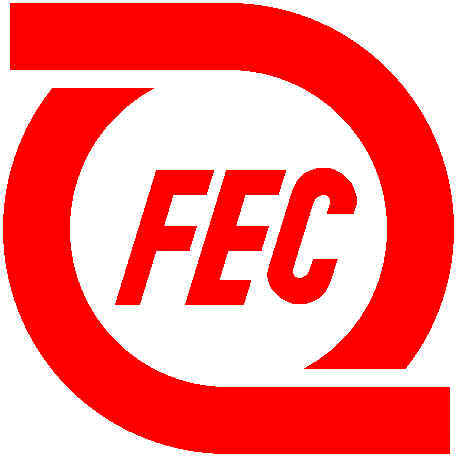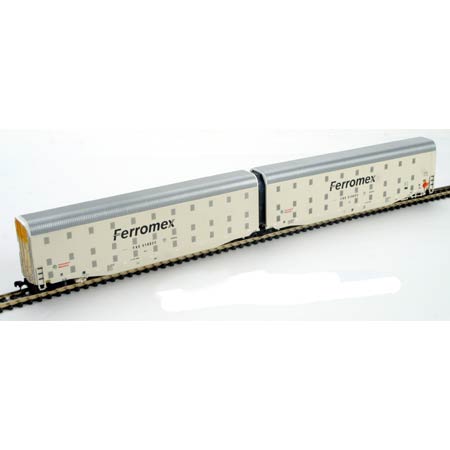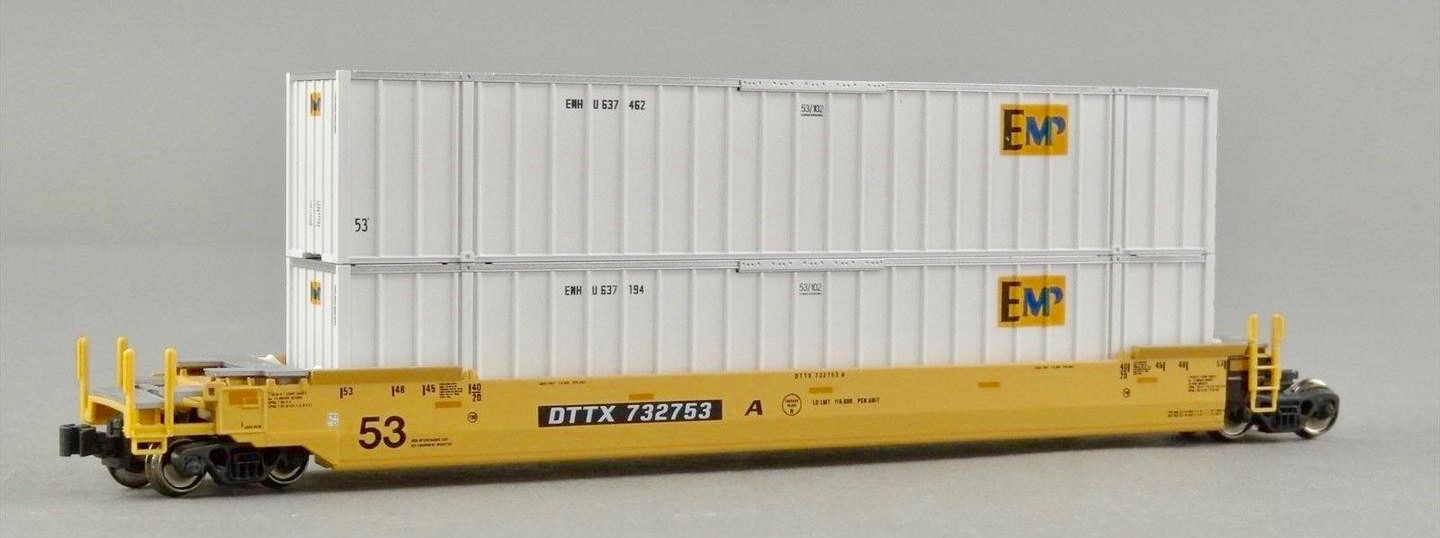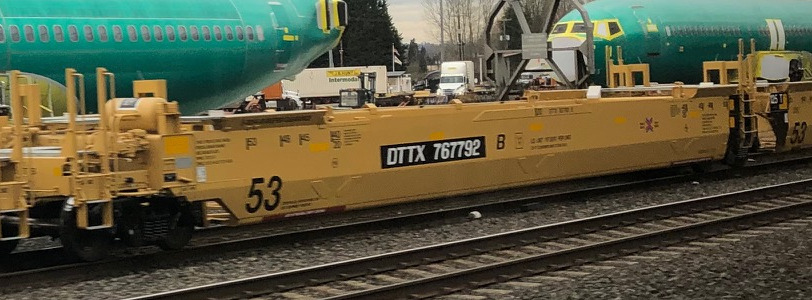Atlas - 50 005 318 - Container Car, Single Well, Gunderson Husky Stack 53 - Florida East Coast - 71116
| Stock Number | 50 005 318 |
| Original Retail Price | $34.95 |
| Brand | Atlas |
| Manufacturer | Atlas |
| Body Style | Atlas Container Car 53 Foot Well |
| Prototype Vehicle | Container Car, Single Well, Gunderson Husky Stack 53 (Details) |
| Road or Company Name | Florida East Coast (Details) |
| Reporting Marks | FEC |
| Road or Reporting Number | 71116 |
| Paint Color(s) | Yellow |
| Print Color(s) | Black, White and Red |
| Coupler Type | AccuMate Magnetic Knuckle |
| Coupler Mount | Body-Mount |
| Wheel Type | Chemically Blackened Metal |
| Wheel Profile | Small Flange (Low Profile) |
| Announcement Date | 2019-09-10 |
| Release Date | 2020-10-01 |
| Item Category | Rolling Stock (Freight) |
| Model Type | Container Car |
| Model Subtype | Well |
| Model Variety | 53 Foot |
| Prototype Region | North America |
| Prototype Era | NA Era V: Modern Diesel (1979 - Present) |
| Scale | 1/160 |
| Track Gauge | N standard |
Model Information:
Atlas first released this model in June of 2019. It was followed up by an announced second release in January of 2020. The model features: Die-cast body;
Detailed brake lines;
Detailed air reservoir;
Separate hand grabs;
Etched metal walks;
Minimum radius: 12-1/2".
Prototype History:
Double-stack container trains first hit the rails for regular service in 1981. The Southern Pacific Railroad had developed the idea to provide service for the Sea- Land maritime shipping company. SP's pioneering double-stack service let Sea- Land's containers take a shortcut from the west coast to the Gulf of Mexico bypassing the Panama Canal. From prototype car to production order, the SP spent a little over four years on the double-stack development project. The SP's double-stack cars featured unwieldy bulkheads on each end to prevent the loose top container from blowing off of the car. A new group at Greenbrier Intermodal designed a similar bulkhead car, even as other companies were starting to leave the bulkheads off of their stack cars. The support for the upper container came from inter-box connectors (IBCs) which had been used for years in oceangoing container shipping. Greenbrier and their car builder, Gunderson, wanted to get in on that market, and did so with their Maxi-Stack cars. But there was another new market out there: developing a single, two-truck stack car. Almost all of the existing cars in service were articulated, with the exception of one SP prototype car.
David DeBoer, a co-founder of Greenbrier, had been seeking to fill this single-well stack car niche, despite the "intermodal experts" at Trailer Train Corp. insisting that the only single-well car that could ride smoothly was a European-style 2-axle car. (In fact, it was DeBoer who wrote the reference book I used for much of this background. His Piggyback and Containers is a highly recommended read, and it was my first review item for MRN.) DeBoer sought advice from his retired former boss at the SP. This pitted the Doubting Thomases at TTX up against Bill Thomford, who had developed the SP's double-stack prototypes. Thomford laughed off Trailer Train's existence, pointing out that his own single-well, two-truck stack car had a million miles of reliable service under its belt. DeBoer went back to Greenbrier and the company got to work designing the car that TTX said was doomed to failure.
In 1990, Gunderson turned out the Husky Stack. Test engineers proved Thomford right, and the cars tracked perfectly. Trailer Train ended up reversing their initial claims and ordering 150 Husky Stack cars built with 48-foot wells in 1991. The Burlington Northern also ordered 75 cars and other buyers lined up later. The original 1991 model cars are still going strong for many different owners, including Trailer Train.
Husky Stack development has continued today, with the introduction of 53-foot wells and the "All-Purpose" Husky Stack, with trailer hitches on each end. In Greenbrier terms, the car is named the HS53 for the 53-foot well version.
David DeBoer, a co-founder of Greenbrier, had been seeking to fill this single-well stack car niche, despite the "intermodal experts" at Trailer Train Corp. insisting that the only single-well car that could ride smoothly was a European-style 2-axle car. (In fact, it was DeBoer who wrote the reference book I used for much of this background. His Piggyback and Containers is a highly recommended read, and it was my first review item for MRN.) DeBoer sought advice from his retired former boss at the SP. This pitted the Doubting Thomases at TTX up against Bill Thomford, who had developed the SP's double-stack prototypes. Thomford laughed off Trailer Train's existence, pointing out that his own single-well, two-truck stack car had a million miles of reliable service under its belt. DeBoer went back to Greenbrier and the company got to work designing the car that TTX said was doomed to failure.
In 1990, Gunderson turned out the Husky Stack. Test engineers proved Thomford right, and the cars tracked perfectly. Trailer Train ended up reversing their initial claims and ordering 150 Husky Stack cars built with 48-foot wells in 1991. The Burlington Northern also ordered 75 cars and other buyers lined up later. The original 1991 model cars are still going strong for many different owners, including Trailer Train.
Husky Stack development has continued today, with the introduction of 53-foot wells and the "All-Purpose" Husky Stack, with trailer hitches on each end. In Greenbrier terms, the car is named the HS53 for the 53-foot well version.
Road Name History:
The Florida East Coast Railway (reporting mark FEC) is a Class II railroad operating in the U.S. state of Florida and since 2007 has been a subsidiary of Railroad Acquisition Holdings, LLC, itself a subsidiary of Fortress Investment Group, LLC.
The FEC was historically a Class I railroad owned by Florida East Coast Industries (FECI) from 2000-2006, FOXX Holdings from 1983-2000, and the St. Joseph Paper Company prior to 1983.
Built primarily in the last quarter of the 19th century and the first decade of the 20th century, the FEC was a project of Standard Oil principal Henry Morrison Flagler. Flagler originally visited Florida to aid with the health issues faced by his first wife, Mary. A key strategist who worked closely with John D. Rockefeller building the Standard Oil Trust, Henry Flagler noted both a lack of services and great potential during his stay at St. Augustine. He subsequently began what amounted to his second career developing resorts, industries, and communities all along Florida's shores abutting the Atlantic Ocean.
The FEC is possibly best known for building the railroad to Key West, completed in 1912. When the FEC's line from the mainland to Key West was heavily damaged by the Labor Day Hurricane of 1935, the State of Florida purchased the remaining right-of-way and bridges south of Dade County, and they were rebuilt into road bridges for vehicle traffic and became known as the Overseas Highway. However, a greater and lasting Flagler legacy was the developments along Florida's eastern coast.
During the Great Depression, control was purchased by heirs of the du Pont family. After 30 years of fragile financial condition, the FEC, under leadership of a new president, Ed Ball, took on the labor unions. Ball claimed the company could not afford the same costs as larger Class 1 railroads and needed to invest saved funds in its infrastructure, fast becoming a safety issue. Using replacement workers, the company and some of its employees engaged in one of the longest and more violent labor conflicts of the 20th century from 1963 until 1977. Ultimately, federal authorities had to intervene to stop the violence, which included bombings, shootings and vandalism. However, the courts ruled in the FEC's favor with regard to the right to employ strikebreakers. During this time, Ball invested heavily in numerous steps to improve its physical plant, installed various forms of automation,was the first US Railroad to operate two man train crews, eliminate cabooses and end all of its passenger services (which were unprofitable) by 1968.
In modern times, the company's primary rail revenues come from its intermodal and rock trains. Since 2007, it has been owned by Fortress Investment Group,[citation needed] which acquired it for over US$3 billion (including non-rail assets). Fortress previously owned conglomerate short line railroad operator RailAmerica, which for a time operated FEC but the two companies never merged; Fortress no longer owns RailAmerica and RailAmerica no longer operates FEC. A former CSX official, James Hertwig, was named as President and Chief Executive Officer of the company effective July 1, 2010.
From Wikipedia
The FEC was historically a Class I railroad owned by Florida East Coast Industries (FECI) from 2000-2006, FOXX Holdings from 1983-2000, and the St. Joseph Paper Company prior to 1983.
Built primarily in the last quarter of the 19th century and the first decade of the 20th century, the FEC was a project of Standard Oil principal Henry Morrison Flagler. Flagler originally visited Florida to aid with the health issues faced by his first wife, Mary. A key strategist who worked closely with John D. Rockefeller building the Standard Oil Trust, Henry Flagler noted both a lack of services and great potential during his stay at St. Augustine. He subsequently began what amounted to his second career developing resorts, industries, and communities all along Florida's shores abutting the Atlantic Ocean.
The FEC is possibly best known for building the railroad to Key West, completed in 1912. When the FEC's line from the mainland to Key West was heavily damaged by the Labor Day Hurricane of 1935, the State of Florida purchased the remaining right-of-way and bridges south of Dade County, and they were rebuilt into road bridges for vehicle traffic and became known as the Overseas Highway. However, a greater and lasting Flagler legacy was the developments along Florida's eastern coast.
During the Great Depression, control was purchased by heirs of the du Pont family. After 30 years of fragile financial condition, the FEC, under leadership of a new president, Ed Ball, took on the labor unions. Ball claimed the company could not afford the same costs as larger Class 1 railroads and needed to invest saved funds in its infrastructure, fast becoming a safety issue. Using replacement workers, the company and some of its employees engaged in one of the longest and more violent labor conflicts of the 20th century from 1963 until 1977. Ultimately, federal authorities had to intervene to stop the violence, which included bombings, shootings and vandalism. However, the courts ruled in the FEC's favor with regard to the right to employ strikebreakers. During this time, Ball invested heavily in numerous steps to improve its physical plant, installed various forms of automation,was the first US Railroad to operate two man train crews, eliminate cabooses and end all of its passenger services (which were unprofitable) by 1968.
In modern times, the company's primary rail revenues come from its intermodal and rock trains. Since 2007, it has been owned by Fortress Investment Group,[citation needed] which acquired it for over US$3 billion (including non-rail assets). Fortress previously owned conglomerate short line railroad operator RailAmerica, which for a time operated FEC but the two companies never merged; Fortress no longer owns RailAmerica and RailAmerica no longer operates FEC. A former CSX official, James Hertwig, was named as President and Chief Executive Officer of the company effective July 1, 2010.
From Wikipedia
Brand/Importer Information:
In 1924 Stephan Schaffan, Sr. founded the Atlas Tool Company in Newark, New Jersey. In 1933 his son, Stephan Schaffan, Jr., came to work for his father at the age of sixteen. Steve Jr. built model airplanes as a hobby and frequented a local hobby shop. Being an enterprising young man, he would often ask the owner if there was anything he could do to earn some extra spending money. Tired of listening to his requests, the hobby-store owner threw some model railroad track parts his way and said, "Here, see if you can improve on this".
In those days, railroad modelers had to assemble and build everything from scratch. Steve Jr. created a "switch kit" which sold so well, that the entire family worked on them in the basement at night, while doing business as usual in the machine shop during the day.
Subsequently, Steve Jr. engineered the stapling of rail to fiber track, along with inventing the first practical rail joiner and pre-assembled turnouts and flexible track. All of these products, and more, helped to popularize model railroading and assisted in the creation of a mass-market hobby. The budding entrepreneur quickly outgrew the limitations of a basement and small garage operation. Realizing they could actually make a living selling track and related products, Steve and his father had the first factory built in Hillside, New Jersey at 413 Florence Avenue in 1947. On September 30, 1949, the Atlas Tool Company was officially incorporated as a New Jersey company.
In 1985, Steve was honored posthumously for his inventions by the Model Railroad Industry Association and was inducted into the Model Railroad Industry Hall of Fame in Baltimore, Maryland. In addition, Steve was nominated and entered into the National Model Railroad Association Pioneers of Model Railroading in 1995.
In the early 1990s, the Atlas Tool Company changed its name to Atlas Model Railroad Company, Inc.
In those days, railroad modelers had to assemble and build everything from scratch. Steve Jr. created a "switch kit" which sold so well, that the entire family worked on them in the basement at night, while doing business as usual in the machine shop during the day.
Subsequently, Steve Jr. engineered the stapling of rail to fiber track, along with inventing the first practical rail joiner and pre-assembled turnouts and flexible track. All of these products, and more, helped to popularize model railroading and assisted in the creation of a mass-market hobby. The budding entrepreneur quickly outgrew the limitations of a basement and small garage operation. Realizing they could actually make a living selling track and related products, Steve and his father had the first factory built in Hillside, New Jersey at 413 Florence Avenue in 1947. On September 30, 1949, the Atlas Tool Company was officially incorporated as a New Jersey company.
In 1985, Steve was honored posthumously for his inventions by the Model Railroad Industry Association and was inducted into the Model Railroad Industry Hall of Fame in Baltimore, Maryland. In addition, Steve was nominated and entered into the National Model Railroad Association Pioneers of Model Railroading in 1995.
In the early 1990s, the Atlas Tool Company changed its name to Atlas Model Railroad Company, Inc.
Item created by: CNW400
on 2019-09-11 13:22:11
Last edited by: gdm on 2021-03-02 11:37:19
If you see errors or missing data in this entry, please feel free to log in and edit it. Anyone with a Gmail account can log in instantly.
Last edited by: gdm on 2021-03-02 11:37:19
If you see errors or missing data in this entry, please feel free to log in and edit it. Anyone with a Gmail account can log in instantly.











